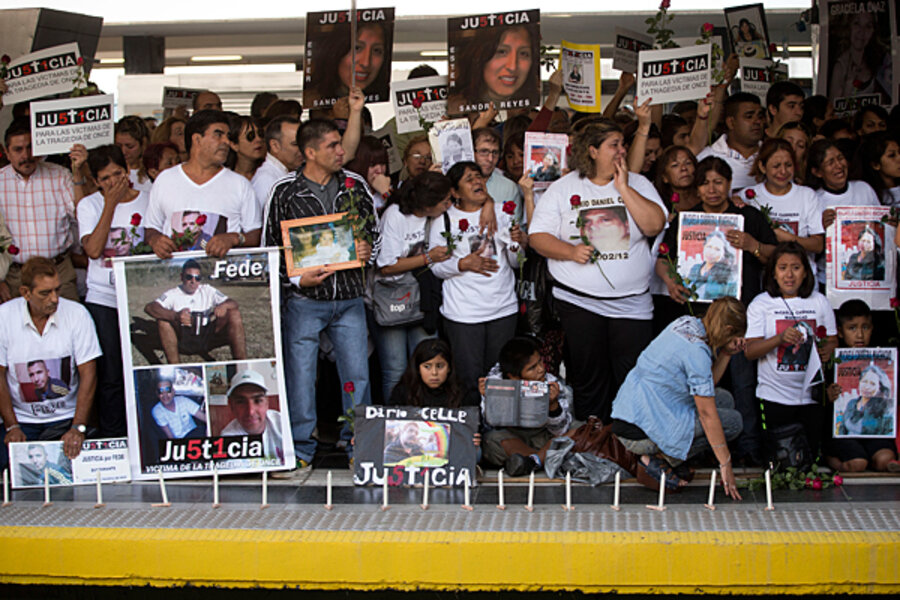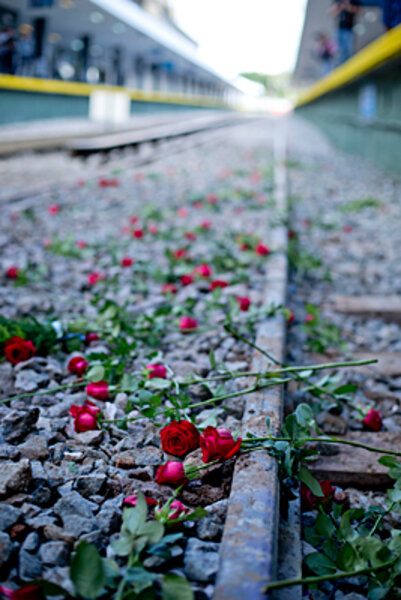Year after Once train crash, Argentine anger still seethes
| Buenos Aires
Paolo Menghini's t-shirt bears the face of his son, Lucas, a victim of one of Argentina's deadliest train accidents, which occurred a year ago today.
The crash at Once train station in Buenos Aires killed a total of 51 people, and will be commemorated this evening by the victims' families, led by Mr. Menghini. Argentina’s trains, however, are still unsafe.
The crash at Once was not an isolated incident. In the first six months of 2012, there were more than 1,200 accidents and 190 deaths on Argentina’s main train lines, according to a government document.
The grieving families blame the current government of Cristina Fernández de Kirchner for the deaths of their relatives, saying it did nothing to improve a system that deteriorated after it was privatized in the 1990s.
“The government is not a bystander,” says Menghini, whose son was 20 when he died. “It stands accused. It knew what could happen and did nothing.” Two former government transport secretaries, Ricardo Jaime and Juan Pablo Schiavi, are indicted in the case, but a trial date has yet to be set.
Argentina’s railways were privatized at the beginning of the 1990s, when concessions for various routes were auctioned off by Carlos Menem’s administration. The contracts, however, favored the operators and made it difficult to enforce sanctions and fines, says Pablo Martorelli, president of the Argentine Railway Institute. He believes a period of increased state control is forthcoming.
“The government allowed the companies to manage themselves. They stopped investing, and complaints about safety and security fell on deaf ears,” says Sergio García, editor of Todo Trenes magazine, dedicated to the railway industry.
President Kirchner announced last month the government will invest $1 billion in the country’s railways, and will replace the aging trains of the Sarmiento line, along which the crash took place, with 400 new Chinese wagons. In July, it withdrew the concession held by Trenes de Buenos Aires (TBA) to operate the Sarmiento and Mitre lines.
But critics say the moves are belated.
“Once is the best example of Kirchnerism’s failure to act,” says Leandro Bullor, an analyst at the University of Buenos Aires, using the term that refers to Argentina’s politics since 2003, when Néstor Kirchner, the President's late husband and predecessor, came to power.
Kirchnerism also allowed years of mismanagement of oil company YPF before renationalizing it last year, Mr. Bullor says. In the case of the railways, despite government spending on the network, politicians are believed to have allowed a handful of businessmen to misappropriate substantial state subsidies while ignoring damning safety reports. Alleged corruption has been at the heart of recent protests against Kirchner.
Since 1991, Argentina’s usable railway network has dropped by 9,300 miles to around 11,800 miles today. Only 3,700 miles are considered safe for passengers, who are packed into carriages. Inter-city journeys are slow: It takes 20 hours to travel the nearly 500 miles from Córdoba to Buenos Aires.
“It’s not enough to buy new trains,” says Mr. García. “The tracks are decrepit. There needs to be a long-term plan.”
The current government has repeatedly failed to mention Once as it seeks to absolve itself of responsibility for the crash, victims' families say. Kirchner only mentioned the crash once over the course of 11 months, in addition to offering her condolences to the victims’ families last night.
Her supporters pin the blame on former President Menem, but he is an overused scapegoat for Argentina’s current problems, says Bullor, the analyst.
“Fifty-one people died because of this government’s indolence,” saysPaolo Menghini. “There needs to be a profound change since, as things stand, the tragedy of Once could repeat itself tomorrow.”






